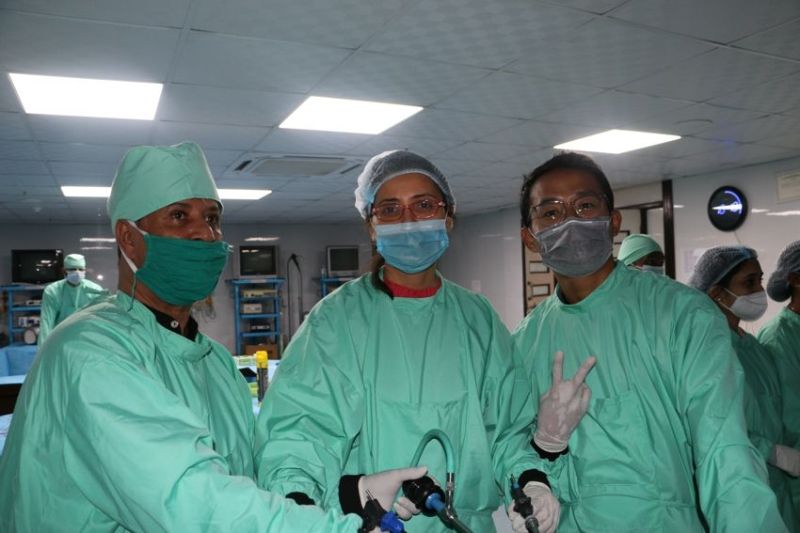Event Date: Sat - 19 Feb, 2022
Event Time: 12:00 am - 12:00 am
Location: World Laparoscopy Hospital
Institute: WLH
Laparoscopic sacrohysteropexy for uterine prolapse and small bowel resection with end-to-end anastomosis, and the suturing and knotting techniques commonly used in these procedures.
Laparoscopic sacrohysteropexy is a minimally invasive surgical procedure used to treat uterine prolapse, a condition in which the uterus descends into the vaginal canal. During the procedure, the surgeon makes several small incisions in the abdomen and inserts specialized instruments, including a camera, to visualize the surgical site. The uterus is then attached to the sacrum, a triangular bone at the base of the spine, to provide support and prevent further prolapse.
Small bowel resection with end-to-end anastomosis is a surgical procedure used to remove a portion of the small intestine and reattach the remaining sections using sutures or staples. This procedure may be necessary for patients with conditions such as tumors, obstructions, or inflammatory bowel disease.
Suturing and knotting techniques are essential skills for surgeons performing these procedures. These techniques involve the use of specialized instruments and suture materials to sew tissues together and create strong, secure knots that hold the tissues in place.
During a live tissue demonstration, Prof Dr. R.K. Mishra may demonstrate the operative steps of laparoscopic sacrohysteropexy and small bowel resection with end-to-end anastomosis, as well as provide guidance and instruction on the suturing and knotting techniques used in these procedures. The demonstration may include a live surgical video or simulation, allowing the audience to observe the techniques and procedures in real-time.
If you are a gynecologist or surgeon interested in learning more about laparoscopic surgical techniques, including suturing and knotting, you may want to attend workshops or training sessions conducted by experienced professionals such as Prof Dr. R.K. Mishra. Additionally, there are many resources available online that provide information on laparoscopic and robotic surgery, including instructional videos and tutorials. It is always important to ensure that any training or instruction you receive is from a qualified and experienced professional.
World Laparoscopy Hospital: A Hub of Contemporary Learning with Daily 8-Hour Hands-On Laparoscopic Training
In the realm of medical education and training, there are institutions that stand out as pioneers, constantly pushing the boundaries of what is possible. One such institution is the World Laparoscopy Hospital, where a contemporary event unfolds every day, featuring a remarkable 8-hour hands-on laparoscopic training program.
A Daily Revolution in Learning
At the heart of the World Laparoscopy Hospital's mission is the commitment to train the next generation of surgeons and medical professionals in the art and science of Minimal Access Surgery. What makes this institution truly exceptional is its daily 8-hour hands-on laparoscopic training program.
The Laparoscopic Revolution
Laparoscopic surgery, often referred to as minimally invasive surgery, has revolutionized the field of surgery in recent decades. Instead of large incisions, this technique involves making tiny keyhole-like openings through which a camera and surgical instruments are inserted. This results in significantly reduced patient trauma, shorter recovery times, and less post-operative pain.
The Daily Experience at World Laparoscopy Hospital
Every day at World Laparoscopy Hospital is a contemporary event in the world of medical education. Here's a glimpse into what a typical day looks like for those fortunate enough to train at this prestigious institution:
1. Intensive Training: The 8-hour hands-on laparoscopic training is an immersive experience where trainees work side by side with experienced surgeons. This hands-on approach ensures that students gain practical skills and confidence in performing laparoscopic procedures.
2. State-of-the-Art Facilities: The hospital boasts state-of-the-art facilities, equipped with the latest laparoscopic instruments and technology. Trainees have access to the same tools and equipment used in modern surgical practices around the world.
3. Expert Faculty: The training is conducted under the guidance of expert faculty members who are pioneers in the field of Minimal Access Surgery. Their wealth of knowledge and experience provides students with invaluable insights and mentorship.
4. Customized Curriculum: The training program is tailored to the specific needs and experience levels of each student. Whether you are a novice or an experienced surgeon looking to refine your skills, there is a program to suit your requirements.
5. Global Reach: World Laparoscopy Hospital attracts medical professionals from all corners of the world. This diverse group of trainees fosters cross-cultural exchanges and collaborations, enriching the learning experience.
6. Research Opportunities: Beyond the hands-on training, the hospital also serves as a hub for research and innovation in the field of Minimal Access Surgery. Trainees have the opportunity to participate in cutting-edge research projects.
Impact Beyond the Classroom
The impact of the daily 8-hour hands-on laparoscopic training at World Laparoscopy Hospital extends far beyond the classroom. Graduates of this program return to their respective countries armed with advanced skills, contributing to the global dissemination of minimally invasive surgical techniques. Patients around the world benefit from the reduced invasiveness, faster recoveries, and improved outcomes that these skilled professionals bring to their practice.
In conclusion, World Laparoscopy Hospital's commitment to daily 8-hour hands-on laparoscopic training is a testament to its dedication to excellence in medical education. By offering a world-class learning environment and fostering a culture of innovation, this institution is shaping the future of surgery, one trainee at a time. It is not just an institution; it is a beacon of hope for patients and a driving force in advancing the field of surgery.


